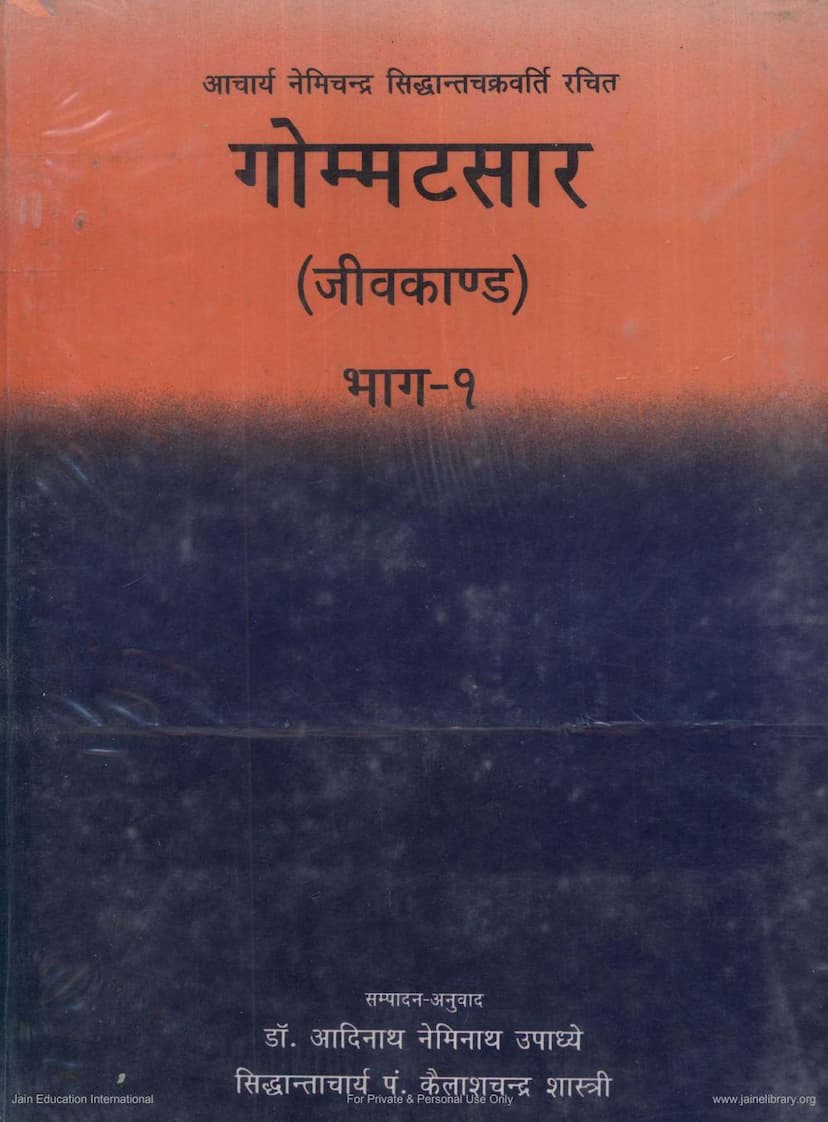Gommatasara Jiva Kanda Part 1
Added to library: September 1, 2025

Summary
The provided text is the first volume of Gommatasara's Jiva Kanda, a significant Jain text authored by Nemichandra Siddhanta Chakravarti. This comprehensive summary is based on the provided pages, including the introductory sections and the beginning of the Jiva Kanda itself.
Book Overview:
- Title: Gommatasara Jiva Kanda, Part 1 (गोम्मटसार जीवकाण्ड, भाग-१)
- Author: Acharya Nemichandra Siddhanta Chakravarti (आचार्य नेमिचन्द्र सिद्धान्तचक्रवर्ती)
- Editors/Translators: Dr. Adinath Nemnath Upadhye (डॉ. आदिनाथ नेमिनाथ उपाध्ये) and Pt. Kailashchandra Shastri (पं. कैलाशचन्द्र शास्त्री)
- Publisher: Bharatiya Gyanpith (भारतीय ज्ञानपीठ)
- Publication: This edition is the Third Edition, published in 2000. The first publication was in 1978-1981 by Bharatiya Gyanpith in four large volumes, containing the Prakrit original gathas, Sanskrit commentary (Jivatattva Pradipika by Shrimat Keshavavarni), and Hindi translation with a detailed introduction.
- Significance: Gommatasara is a monumental work that extensively explains the Jiva (Soul) and Karma principles of Jainism. Composed in the 10th century, it is considered a popular and handy work on metaphysics and ontology, largely based on the Satkhandagama and its commentaries.
Key Themes and Content:
- Purpose of Gommatasara: The text aims to provide a detailed explanation of the Jiva Tattva (Soul principle) and Karma Siddhanta (Doctrine of Karma) in Jainism. It serves as an introduction to the great element of Jiva or Consciousness.
- Nature of Jiva (Soul): Jainism posits the soul as an eternal, indestructible, and independent entity. Souls are infinite, each possessing infinite attributes and qualities.
- Consciousness: Consciousness is described as the characteristic of life, attentiveness of conation or of knowledge itself. It is the primary differentiator between the living and the non-living. The living possess ten vitalities, including the five senses, mind, speech, body, respiration, and age, which the non-living lack.
- Classification of Souls: The text touches upon the Jain theory of Numbers to understand omniscience, mentioning categories like Samkhyāta (countable), Asamkhyäta (innumerable), and Ananta (infinite).
- The Author and His Context: Acharya Nemichandra Siddhanta Chakravarti lived in the 10th century. The book is dedicated to the study and contemplation of Jain philosophy. The name "Gommatasara" is linked to Chamundaraya, a minister and general of the Ganga Empire, who was also known as Gommataraya and whose statue is famous in Shravanabelagola.
- Connection to Ancient Jain Literature: Gommatasara is deeply rooted in earlier Jain canonical scriptures like Satkhandagama and Kashayaprahuda, which themselves are considered remnants of the fourteen Purvas, the most ancient Jain texts.
- The Jiva Kanda: This specific part focuses on the Jiva or Soul, detailing its nature, characteristics, and the principles related to it. It is stated to consist of 734 gathas (verses).
- Commentaries: The edition includes the original Prakrit gathas, the Sanskrit commentary "Jivatattva Pradipika" by Shrimat Keshavavarni, and a Hindi translation. The preface also discusses the historical context and the contributions of scholars like Dr. A.N. Upadhye and Pt. Kailash Chandra Shastri in bringing this text to light.
- Mathematical Concepts: The text mentions that the author deals with topics similar to mathematical equations, including algebra, geometry (squares, cubes), permutations and combinations, place value notation, numeral systems, sequences, progressions, and mensuration, which are found in various ancient Jain scriptures.
- Editorial Notes and Introduction: The preface (Prastavana) provides significant insights into the history of the text, the origins of its name, the lineage of its commentators, and the philosophical context of Jainism, particularly the importance of the doctrine of Karma and the structure of the Twelve Angas and Fourteen Purvas. It highlights the seminal role of the Satkhandagama and its commentaries like Dhavala in shaping Jain philosophical thought.
- Key Topics Covered in the Introduction:
- Importance of the Purvas: The ancient texts and their knowledge holders.
- Karma Siddhanta: The Jain concept of karma as subtle matter and its bondage to the soul due to passions (Kashaya).
- Significance of Satkhandagama: Its influence and the origin of the title "Siddhanta Chakravarti."
- Origin of the Name "Gommatasara": Its connection to Chamundaraya and the statue of Bahubali.
- Guru Lineage of Nemichandra: Mentions of his gurus like Ajit Sen, Abhaynandi, Veeranandi, and Indranandi.
- Place of Composition: Likely Chandragiri, near Shravanabelagola.
- Date of Composition: Around 1037-1040 AD, coinciding with the works of Chamundaraya.
- Other Works of Nemichandra: Mention of Labdhisara and Trilokyasara.
- Commentaries on Gommatasara: Discusses Mandaprobodhika (by Abhayachandracharya), Karnatika Vritti (by Keshavavarni), and Samyagjnanachandrika (by Pt. Todarmal).
- Detailed Explanation of Topics: The introduction provides a glimpse into the content, which includes detailed discussions on Gunsthanas (stages of spiritual development) and Marganas (modes of existence or inquiry), covering topics like consciousness, senses, body, passions, knowledge, conduct, delusions, passions, knowledge, restraint, perception, predispositions, karma, etc.
In essence, this volume of Gommatasara Jiva Kanda is a foundational text in Jain philosophy, offering a systematic and intricate analysis of the soul and its journey through various states of existence, deeply influenced by the concept of karma. The provided text focuses heavily on introducing the work, its author, commentaries, and the historical and philosophical background, along with a detailed breakdown of the initial concepts like Gunsthanas and Marganas.